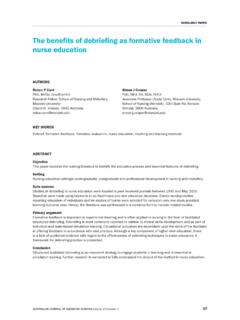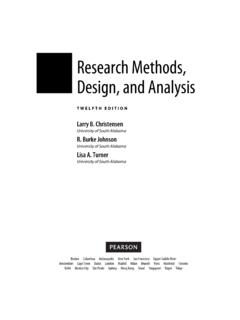Transcription of Experimental Design 1 - ed
1 Experimental Design 1 Running Head: Experimental Design Experimental Design and Some Threats to Experimental Validity: A Primer Susan Skidmore Texas A&M University Paper presented at the annual meeting of the Southwest Educational research Association, New Orleans, Louisiana, February 6, 2008. Experimental Design 2 Abstract Experimental designs are distinguished as the best method to respond to questions involving causality. The purpose of the present paper is to explicate the logic of Experimental Design and why it is so vital to questions that demand causal conclusions. In addition, types of internal and external validity threats are discussed. To emphasize the current interest in Experimental designs, Evidence-Based Practices (EBP) in medicine, psychology and education are highlighted.
2 Finally, cautionary statements regarding Experimental designs are elucidated with examples from the literature. Experimental Design 3 The No Child Left Behind Act (NCLB) demands scientifically based research as the basis for awarding many grants in education (2001). Specifically, the 107th Congress (2001) delineated scientifically-based research as that which is evaluated using Experimental or quasi - Experimental designs . Recognizing the increased interest and demand for scientifically-based research in education policy and practice, the National research Council released the publication, Scientific research in Education (Shavelson & Towne, 2002) a year after the implementation of NCLB. Almost $5 billion have been channeled to programs that provide scientifically-based evidence of effective instruction, such as the Reading First Program (U.)
3 S. Department of Education, 2007). With multiple methods available to education researchers, why does the U. S. government show partiality to one particular method? The purpose of the present paper is to explicate the logic of Experimental Design and why it is so vital to questions that demand causal conclusions. In addition, types of internal and external validity threats are discussed. To emphasize the current interest in Experimental designs, Evidence-Based Practices (EBP) in medicine, psychology and education are highlighted. Finally, cautionary statements regarding Experimental designs are elucidated with examples from the literature. Experimental Design An experiment is that portion of research in which variables are manipulated and their effects upon other variables observed (Campbell & Stanley, 1963, p.
4 171). Or stated another way, experiments are concerned with an independent variable (IV) that causes or predicts the outcome of the Experimental Design 4 dependent variable (DV). Ideally, all other variables are eliminated, controlled or distributed in such a way that a conclusion that the IV caused the DV is validly justified. Figure 1. Diagram of an experiment. In Figure 1 above you can see that there are two groups. One group receives some sort of manipulation that is thought (theoretically or from previous research ) to have an impact on the DV. This is known as the Experimental group because participants in this group receive some type of treatment that is presumed to impact the DV. The other group, which does not receive a treatment or instead receives some type of alternative treatment, provides the result of what would have happened without Experimental intervention (manipulation of the IV).
5 So how do you determine whether participants will be in the control group or the Experimental group? The answer to this question is one of the characteristics that underlie the strength of true Experimental designs. True experiments must have three essential characteristics: random assignment to Outcome measured as DV No manipulation or alternate manipulation of IV (treatment or intervention) Control Group Manipulation of IV (treatment or intervention) Experimental Group Experimental Design 5 groups, an intervention given to at least one group and an alternate or no intervention for at least one other group, and a comparison of group performances on some post-intervention measurement (Gall, Gall, & Borg, 2005). Participants in a true Experimental Design are randomly allocated to either the control group or the Experimental group.
6 A caution is necessary here. Random assignment is not equivalent to random sampling. Random sampling determines who will be in the study, while random assignment determines in which groups participants will be. Random assignment makes samples randomly similar to each other, whereas random sampling makes a sample similar to a population (Shadish, Cook, & Campbell, 2002, p. 248, emphasis in original). Nonetheless, random assignment is extremely important. By randomly assigning participants (or groups of participants) to either the Experimental or control group, each participant (or groups of participants) is as likely to be assigned to one group as to the other (Gall et al., 2005). In other words, by giving each participant an equal probability of being a member of each group, random assignment equates the groups on all other factors, except for the intervention that is being implemented, thereby ensuring that the experiment will produce unbiased estimates of the average treatment effect (Rosenbaum, 1995, p.)
7 37). To be clear, the term unbiased estimates describes the fact that any observed effect differences between the study results and the true population are due to chance (Shadish et al., 2002). Experimental Design 6 This equality of groups assertion is based on the construction of infinite number of random assignments of participants (or groups of participants) to treatment groups in the study and not to the single random assignment in the particular study (Shadish et al., 2002). Thankfully, researchers do not have to conduct an infinite number of random assignments in an infinite number of studies for this assumption to hold. The equality of groups assumption is supported in studies with large sample sizes, but not in studies with very small sample sizes. This is true due to the law of large numbers.
8 As Boger (2005) explained, If larger and larger samples are successively drawn from a population and a running average calculated after each sample has been drawn, the sequence of averages will converge to the mean, , of the population (p. 175). If the reader is interested in exploring this concept further, the reader is directed to George Boger s article that details how to create a spreadsheet simulation of the law of large numbers. In addition, a medical example of this is found in Observational Studies (Rosenbaum, 1995, pp. 13-15). To consider the case of small sample size, let us suppose that I have a sample of 10 graduate students that I am going to randomly assign to one of two treatment groups. The Experimental group will have regularly scheduled graduate advisor meetings to monitor students educational progress.
9 The control group will not have regularly scheduled graduate advisor meetings. Just to see what happens, I choose to do several iterations of this random assignment process. Of course, I discover that the identity of the members in the groups across iterations is wildly different. Experimental Design 7 Recognizing that most people are outliers on at least some variables (Thompson, 2006), there may be some observed differences that are due simply to the variable characteristics of the members of the treatment groups. For example, let s say that six of the ten graduate students are chronic procrastinators, and might benefit greatly from regular scheduled visits with a graduate advisor, while four of the ten graduate students are intrinsically motivated and tend to experience increased anxiety with frequent graduate advisor inquiries.
10 If the random assignment process distributes these six procrastinator graduate students equally among the two groups, a bias due to this characteristic will not evidence itself in the results. If instead, due to chance all four intrinsically motivated students end up in the Experimental group, the results of the study may not be the same had the groups been more evenly distributed. Ridiculously small sample sizes, therefore would result in more pronounced differences between the groups that are not due to treatment effects, but instead are due to the variable characteristics of the members in the groups. If instead I have a sample of 10,000 graduate students that that I am going to randomly assign to one of two treatment groups, the law of large numbers works for me. As explained by Thompson et al.



















